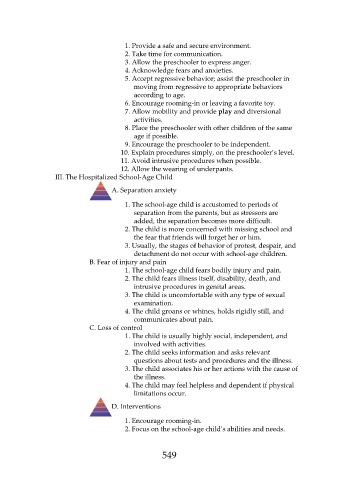Page 549 - Saunders Comprehensive Review For NCLEX-RN
P. 549
1. Provide a safe and secure environment.
2. Take time for communication.
3. Allow the preschooler to express anger.
4. Acknowledge fears and anxieties.
5. Accept regressive behavior; assist the preschooler in
moving from regressive to appropriate behaviors
according to age.
6. Encourage rooming-in or leaving a favorite toy.
7. Allow mobility and provide play and diversional
activities.
8. Place the preschooler with other children of the same
age if possible.
9. Encourage the preschooler to be independent.
10. Explain procedures simply, on the preschooler’s level.
11. Avoid intrusive procedures when possible.
12. Allow the wearing of underpants.
III. The Hospitalized School-Age Child
A. Separation anxiety
1. The school-age child is accustomed to periods of
separation from the parents, but as stressors are
added, the separation becomes more difficult.
2. The child is more concerned with missing school and
the fear that friends will forget her or him.
3. Usually, the stages of behavior of protest, despair, and
detachment do not occur with school-age children.
B. Fear of injury and pain
1. The school-age child fears bodily injury and pain.
2. The child fears illness itself, disability, death, and
intrusive procedures in genital areas.
3. The child is uncomfortable with any type of sexual
examination.
4. The child groans or whines, holds rigidly still, and
communicates about pain.
C. Loss of control
1. The child is usually highly social, independent, and
involved with activities.
2. The child seeks information and asks relevant
questions about tests and procedures and the illness.
3. The child associates his or her actions with the cause of
the illness.
4. The child may feel helpless and dependent if physical
limitations occur.
D. Interventions
1. Encourage rooming-in.
2. Focus on the school-age child’s abilities and needs.
549

